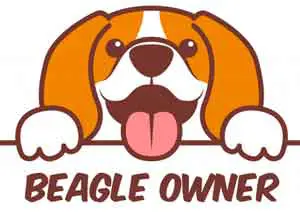
Beagles love to howl, and they can start as early as 8 weeks. They were bred to be hunters, so howling comes natural to them. They howl to notify the pack they are successful on the hunt.
The French word begueule, actually means “open throat”
Beagles tend to howl even when they are bored, needing attention, want to play, or have found something.
They can also howl when they are left alone, this could become annoying to your neighbors.
It can also be a sign that your Beagle needs to go outside or for a walk, he is looking for some stimulation or exercise.
A signature howl is instinctive for Beagles, and all Beagles learn to howl — some sooner than others.
Your Beagle puppy may sing as early as 8 weeks of age or not until his first birthday. But once he starts, he won’t stop. It’s what a beagle does.
What makes a Beagle howl?
Beagles are a hunting breed, and howling is their way of telling their hunter that prey has been sighted or caught.
A Beagle’s howl can be bigger than he is, capable of carrying quite a distance. If there’s no prey to be spotted in your house, he or she will find other reasons to vocalize.
Howling makes a Beagle happy, and may consider many things fair game for howling: the mailman, squirrels in the yard, cars on the road, the wind or a dandelion!
Other Reasons Your Dog will Howl include;
Greeting or Play: Beagles often bark or howl when greeting people or other animals.
Attention Seeking: Beagles often bark or howl when they want something, such as going outside, playing, or getting a treat.
Separation Anxiety: Beagles with separation anxiety often bark or howl excessively when left alone.
The first howl
Some Beagles don’t howl much at all and others may nonstop. Howling can be learned while a puppy is still in the litter.
If a Beagle’s mother or littermates howl, they will all learn to sing before they leave the whelping box. Those who don’t howl as puppies may be inspired by other triggers as they get older.
Your Beagle pup might howl for the first time when he sees bird flying on a walk or hears a loud noise that triggers his instinct.
A quiet Beagle is rare, but chances are that a quiet puppy may be a quiet adult and howl infrequently.
What is the difference between howling, baying and barking?
Beagles have three distinct vocalizations. The Beagle bark is different from a howl.
Beagles have a loud bark, and they will use it to get your attention: for instance, when he/she wants his dinner. Or for everyday things like the doorbell or being offered a treat.
You’ll know their howl when they throw their head back and make a high-pitched, long mournful sound that can’t be mistaken for anything else as if they are sad or bored.
A Beagle also bays, which is his third vocalization. That’s a cross between a bark and a howl. Baying sounds very much like yodeling.
It’s not as long as a howl and has a sharper, harsher sound. They will frequently bay to get attention, which would have been used to alert other dogs of a scent they picked up.
The sounds that Beagles use to communicate with each other, however, have much more uniformity.
These sounds are different for different species, but within any one animal type, there seems to be some sort of fairly common or universal language and there appears to be a universal sound code used by most animals.
It is based on three dimensions: the pitch of the sound, the duration of the sound, and the frequency or repetition rate of the sounds.
Pitch meanings
Low-pitched growls usually indicate threats, anger and the possibility of aggression. These are interpreted as meaning “Stay away from me.”
High pitch sounds mean the opposite, asking to be allowed to come closer or saying that it is safe to approach. The question is why should Beagles use and understand this Law of Pitch?
The answer begins with the simple observation that big things make low sounds.
Since you know that other animals are paying attention to the pitch of your signals you can now deliberately use that as a means of communication.

If you want to make another animal move away, or to stay out of your territory, you could send a lower-pitched signal, like a growl, suggesting that you are larger and more dangerous.
You could also use a high-pitched signal, like a whimper, to suggest that you are rather small, and therefore it is quite safe to approach you.
Similarly, even if you are large, if you wish to signal that you intended no threat or harm when you approached another animal, you could indicate that you intended to act as a small harmless creature by whimpering or whining.
Duration of howl
Generally speaking, the longer the sound, the more likely that your Beagle is making a conscious decision about the nature of the signal and his next behaviors.
Therefore, the threatening growl of a dominant Beagle that has every intention of holding his ground and not backing down will be both low pitched and also long and sustained.
If the growl is in shorter bursts, and only held briefly, it indicates there is an element of fear present and the Beagle is worried about whether it can successfully deal with an attack.

Frequency of howl
Sounds that are repeated often, at a fast rate, indicate a degree of excitement and urgency. Sounds that are spaced out, or not repeated, usually indicate a lower level of excitement.
A Beagle giving an occasional howl or two at the window is only showing mild interest in something.
A Beagle howling in multiple bursts and repeating them many times a minute is signalling that he feels that the situation is important and perhaps even a potential crisis.
Barking is an alarm sound. There is no threat of aggression signaled by the Beagle unless it is lower-pitched and mixed with growls. Let’s consider the interpretation of the most common barks.
- Rapid strings of two to four barks with pauses between is the most common form of barking and is the classic alarm bark meaning something like: “Call the pack. There is something going on that should be looked into.”
- Barking in a fairly continuous string but lower pitch and slower than the usual alarm bark suggests that the Beagle is sensing an imminent problem. This sound means “The danger is very close. I don’t think that he is friendly and get ready to defend yourself.”
- One or two sharp short barks of high or midrange pitch is the most typical greeting sound, and it usually replaces the alarm barks when the visitor is recognized as friendly. Many people are greeted in this way when they walk in the door. It really means, “Hello there!” It’s usually followed with the Beagle’s typical greeting ritual.
- A long string of solitary barks with deliberate pauses between each one is a sign of a lonely Beagle asking for companionship.
- A stutter bark, which sounds something like “Harr-ruff” is usually given with front legs flat on the ground and rear held high and simply means, “Let’s play!”
How to stop your Beagle howling
Once your Beagle learns to howl, it’s tough to make him stop. If the noise is too much for you or your neighbors, you can teach your Beagle to howl less.
Redirect his attention when he begins to howl by throwing a toy for him to fetch or asking him to sit.
Praise him when he obeys, and he’ll quickly learn to simmer down. Beagles are Beagles who love companionship and will sometimes howl because they’re alone.
Leave the TV or a radio playing when you leave to see if that helps, or give your beagle a crate for a security den to nap in when you’re not me.
What not to do!
- Don’t encourage your Beagle to bark at noises and discourage him from barking at others.
- Never use a muzzle or other means of constraint to keep a dog quiet for long periods or when they aren’t supervised. These can be dangerous to your pet.
Debarking procedures are very controversial and are considered inhumane by many.
Hey do not address the underlying cause of the barking. It is a surgical procedure in which the folds of tissue on either side of a dog’s larynx, or voice box, are removed, leaving dogs with a raspy bark instead of a full bark.
Complications are common and can be life threatening, including breathing difficulties, higher incidents of choking, and ongoing pain.
Beagles have been known to regain their voices after the surgery. The procedure does not stop the barking, it only makes it sound different.
You can look at a variety of products which can help to reduce the time spent by your Beagle barking and help to make your Beagle feel more safe, comfortable and secure in your home environment.

Sarah is the Senior Editor at Beagle Owner. An avid reader of crime novels, fashion lover, and walking her Beagle Woody.
